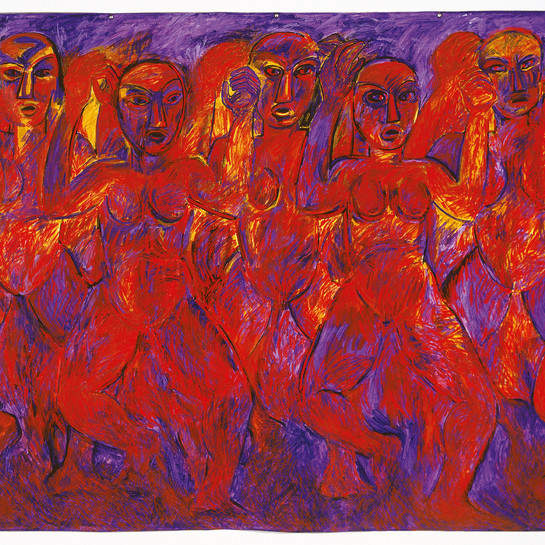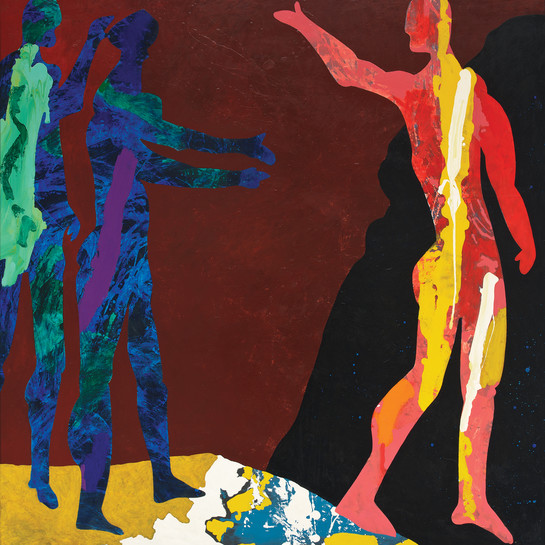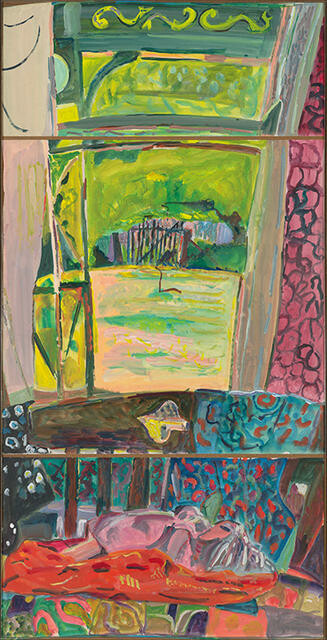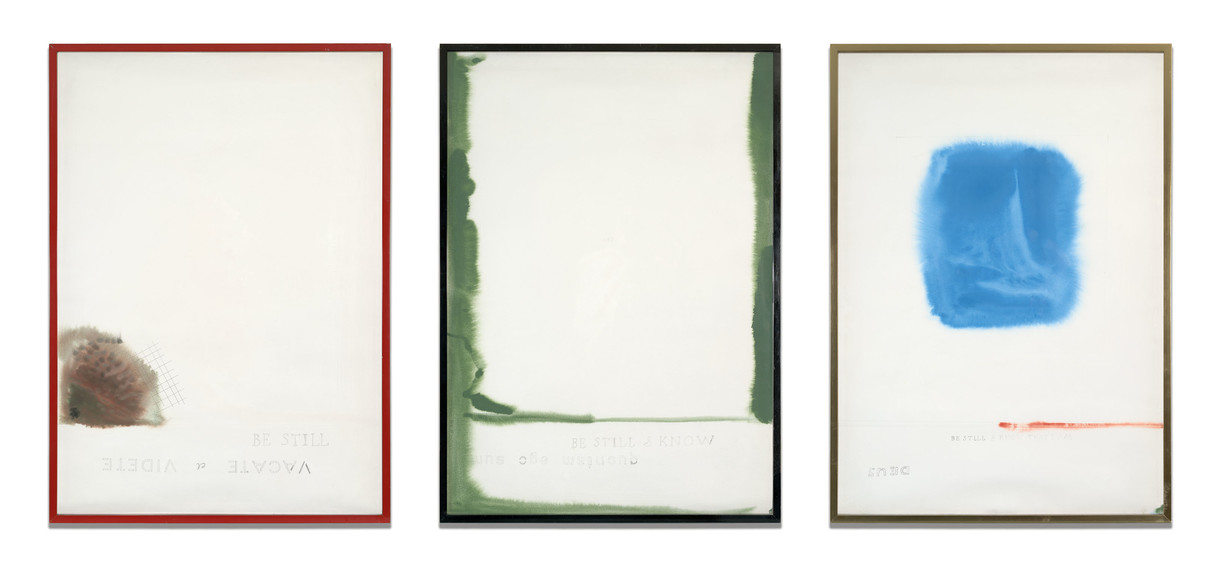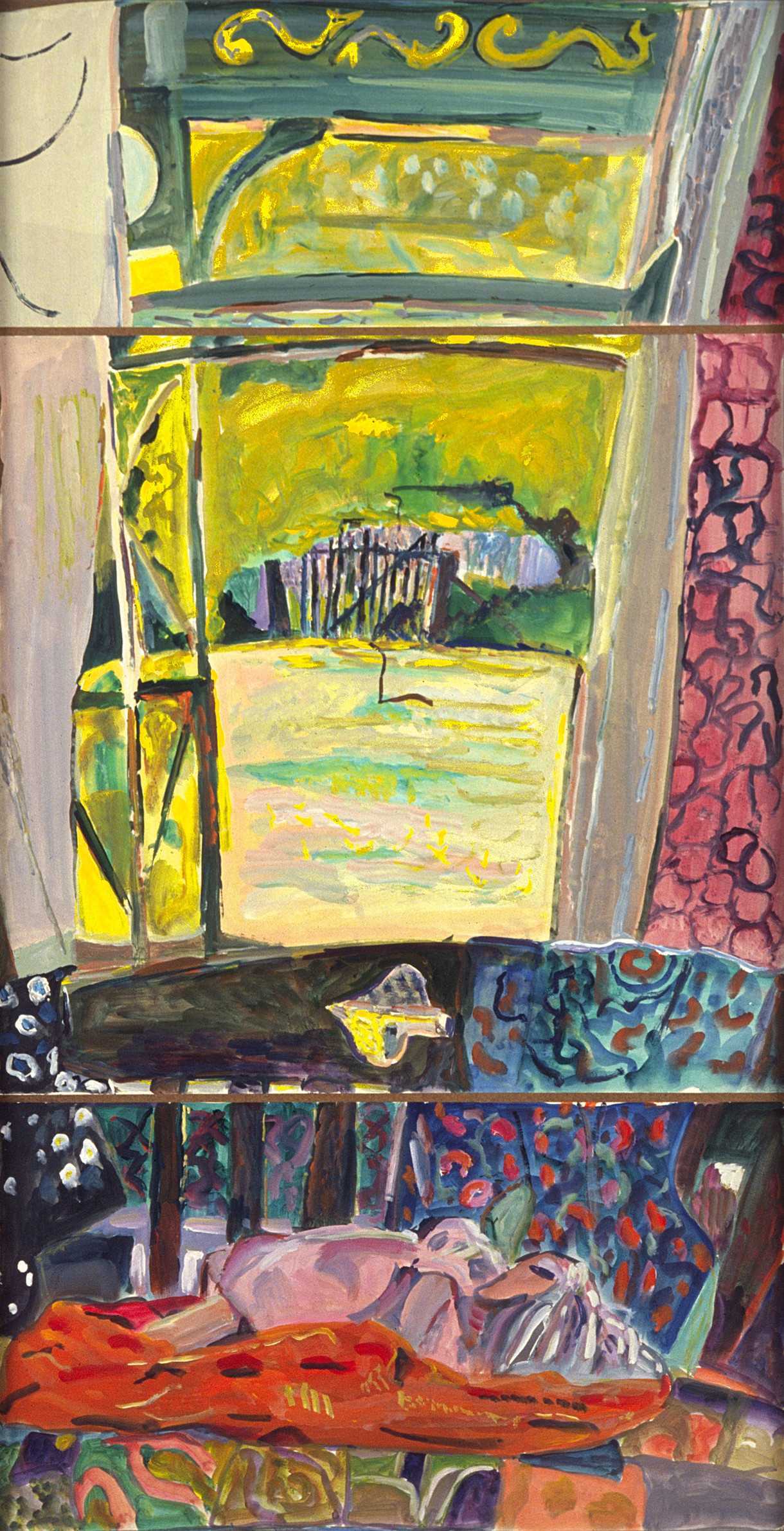Joanna Margaret Paul
Aotearoa New Zealand, b.1945, d.2003
Barrys Bay: Interior with Bed and Doll
- 1974
- Oil and watercolour on paper and hardboard
- Purchased 1974
- 647 x 675mm
- 74/78
- View on google maps
“Through the shaped spaces of the bed’s frame; through the flowers carved in the wood and through the window pane; through the pierced verandah hood, the foliate rose, I see the straight and curved branches parting of a tree. Without the lens heaven, the heavens not understood. Thus domestic life is both subject and metaphor.”
“As a woman, painting is not a job, not even a vocation. It is part of life, subject to the strains, and joys, of domestic life. I cannot paint unless the house is in order. Unless I paint I don’t function well in my domestic roles. Each thing is important. The idea that one sacrifices other values for art is alien to me, and I think to all women whose calling it is to do and be many things. To concentrate all meaning and all energy in a work of art is to leave life dry and banal. I don’t wish to separate the significant and everyday actions but to bring them to close as possible.” —Joanna Margaret Paul, 1975
(Perilous: Unheard Stories from the Collection, 6 August 2022- )
Exhibition History
[We do this, 12 May 2018 - 26 May 2019] (https://christchurchartgallery.org.nz/exhibitions/we-do-this)
“As a woman”, said Joanna Margaret Paul, “painting is not a job, not even a vocation. It is part of life, subject to the strains, and joys, of domestic life. I cannot paint unless the house is in order. Unless I paint I don’t function well in my domestic roles. Each thing is important. The idea that one sacrifices other values for art is alien to me, and I think to all women whose calling is to do and be many things.” Between 1974 and 1977 Paul was living on Banks Peninsula with her young family. This painting is a view of the garden through her window. Recognising that personal subjectivity was “the only mode of truth”, she made art in a variety of forms – paintings, films, photographs, poems – which collectively function like a visual diary of her daily life. “I am aggressively in support of the minor”, she said. “I like my work to relate to a room rather than a gallery.” She was able to locate a world of meaning in the smallest of gestures and the most domestic of subjects. “I’m painting things like the coffee cups after a visitor has left.”
(We do this, 12 May 2018 - 26 May 2019)
Picturing the Peninsula, 21 April - 22 July 2007
Much of Joanna Margaret Paul’s painting dealt with domestic interiors such as in this work. Here the artist’s viewpoint is not taken from out in the landscape but rather from the domestic setting of a bedroom looking out onto the landscape from within. Barrys Bay, named after a shepherd who settled in the Bay in 1847, is the first Bay encountered on the journey down into Akaroa Harbour from the Hilltop. The Maori name for the Bay is Taraouta.
Joanna Margaret Paul married the artist Jeffrey Harris in 1971 and they moved to Barrys Bay in 1974. Paul died in a tragic accident in 2003 and is buried at Akaroa along with her daughter Imogen.
1969 Comeback Special 27 August – 6 November 2016
Joanna Margaret Paul’s painting views the Banks Peninsula landscape from the domestic setting of her home. Around the time this work was made the artist commented: As a woman, painting is not a job, not even a vocation. It is part of life, subject to the strains, and joys, of domestic life. I cannot paint unless the house is in order. Unless I paint I don’t function well in my domestic roles. Each thing is important. The idea that one sacrifices other values for art is alien to me, and I think to all women whose calling is to do and be many things. To concentrate all meaning and all energy in a work of art is to leave life dry and banal. I don’t wish to separate the significant and everyday actions but to bring them to close as possible together. It is natural for women to do this; their exercise and their training and their artistry is in daily living. Painting for me as a woman is an ordinary act – about the great meaning in ordinary things. Anonymity pattern utility quietness relatedness.
![Joanna Margaret Paul Frugal Pleasures [still life with statuette and Latin text] 1999. Gouache and pencil on paper. Collection of David and Keren Skegg, Dunedin, on deposit at Hocken Collections, Uare Taoka o Hākena, University of Otago, L2011/43. Courtesy of the Joanna Margaret Paul Estate](/media/cache/98/68/98687360bff01b9b85f0638a09502047.jpg)

